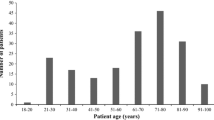Abstract
Over the last several years, carbapenemase-producing Enterobacteriaceae (CPE) have been increasingly detected not only among patients in acute care hospitals, but also in long-term care facilities. In this point prevalence survey, residents from three nursing homes and patients in one rehabilitation center were screened for asymptomatic intestinal carriage of CPE by rectal swabs. The first objective was to evaluate the hypothesis of the establishment of a CPE reservoir in a geriatric/chronic care population. Secondly, we evaluated the comparative performances of different culture methods (chromID® CARBA, chromID® OXA-48, MacConkey with temocillin/meropenem, ertapenem enrichment broth) and a commercial molecular assay (Check-Direct CPE). From the 257 included residents, only one had evidence for CPE carriage. From the rectal swabs of this resident, an OXA-48-producing Klebsiella pneumoniae could be isolated and was confirmed by a molecular assay both on the strain and on the rectal swab. The specificity of the different culture methods and Check-Direct CPE was at least 97 %. Neither enrichment broth nor prolonged incubation up to 48 h increased the yield of CPE. This point prevalence survey shows a low CPE prevalence of 0.39 %. Larger scaled studies are needed in order to confirm the role of chronic care settings as secondary CPE reservoirs and to adjust the infection control and prevention recommendations.
Similar content being viewed by others
References
Nordmann P, Naas T, Poirel L (2011) Global spread of carbapenemase-producing Enterobacteriaceae. Emerg Infect Dis 17:1791–1798. doi:10.3201/eid1710.110655
Reddy P, Malczynski M, Obias A, Reiner S, Jin N, Huang J, Noskin GA, Zembower T (2007) Screening for extended-spectrum beta-lactamase-producing Enterobacteriaceae among high-risk patients and rates of subsequent bacteremia. Clin Infect Dis 45:846–852
Lin MY, Lyles-Banks RD, Lolans K, Hines DW, Spear JB, Petrak R, Trick WE, Weinstein RA, Hayden MK; Centers for Disease Control and Prevention Epicenters Program (2013) The importance of long-term acute care hospitals in the regional epidemiology of Klebsiella pneumoniae carbapenemase-producing Enterobacteriaceae. Clin Infect Dis 57:1246–1252. doi:10.1093/cid/cit500
Huang T-D, Bogaerts P, Berhin C, Jans B, Deplano A, Denis O, Glupczynski Y (2011) Rapid emergence of carbapenemase-producing Enterobacteriaceae isolates in Belgium. Euro Surveill 16(26). pii: 19900
Glupczynski Y, Huang TD, Bouchahrouf W, Rezende de Castro R, Bauraing C, Gérard M, Verbruggen AM, Deplano A, Denis O, Bogaerts P (2012) Rapid emergence and spread of OXA-48-producing carbapenem-resistant Enterobacteriaceae isolates in Belgian hospitals. Int J Antimicrob Agents 39:168–172. doi:10.1016/j.ijantimicag.2011.10.005
British Society for Antimicrobial Chemotherapy (BSAC) (2013) Susceptibility testing methodology, version 13. Available online at: http://bsac.org.uk/susceptibility/methodologylatestversion/. Accessed 5 July 2014
Clinical and Laboratory Standards Institute (CLSI) (2013) Performance standards for antimicrobial susceptibility testing; Twenty-first informational supplement; CLSI document M100-S21. CLSI, Wayne, PA, USA
European Committee on Antimicrobial Susceptibility Testing (EUCAST) (2013) Clinical breakpoints. Available online at: http://www.eucast.org/clinical_breakpoints/. Accessed 5 July 2014
Nijhuis R, Samuelsen O, Savelkoul P, van Zwet A (2013) Evaluation of a new real-time PCR assay (Check-Direct CPE) for rapid detection of KPC, OXA-48, VIM, and NDM carbapenemases using spiked rectal swabs. Diagn Microbiol Infect Dis 77:316–320. doi:10.1016/j.diagmicrobio.2013.09.007
Huang TD, Berhin C, Bogaerts P, Glupczynski Y; Multicentre Study Group (2013) Prevalence and mechanisms of resistance to carbapenems in Enterobacteriaceae isolates from 24 hospitals in Belgium. J Antimicrob Chemother 68:1832–1837. doi:10.1093/jac/dkt096
Zong Z (2012) Discovery of blaOXA-199, a chromosome-based blaOXA-48-like variant, in Shewanella xiamenensis. PLoS One 7:e48280. doi:10.1371/journal.pone.0048280
Hoefnagels-Schuermans A, Niclaes L, Buntinx F, Suetens C, Jans B, Verhaegen J, Van Eldere J (2002) Molecular epidemiology of methicillin-resistant Staphylococcus aureus in nursing homes: a cross-sectional study. Infect Control Hosp Epidemiol 23:546–549
Acknowledgments
chromID® CARBA and chromID® OXA-48 chromogenic agars were kindly provided by bioMérieux.
We are indebted to Noël Saegeman for the logistical support.
Conflict of interest
No conflict of interest to report.
Author information
Authors and Affiliations
Corresponding author
Rights and permissions
About this article
Cite this article
Saegeman, V., Van den Eynde, J., Niclaes, L. et al. Performance of different culture methods and of a commercial molecular assay for the detection of carbapenemase-producing Enterobacteriaceae in nursing homes and rehabilitation centers. Eur J Clin Microbiol Infect Dis 34, 991–997 (2015). https://doi.org/10.1007/s10096-015-2318-9
Received:
Accepted:
Published:
Issue Date:
DOI: https://doi.org/10.1007/s10096-015-2318-9




